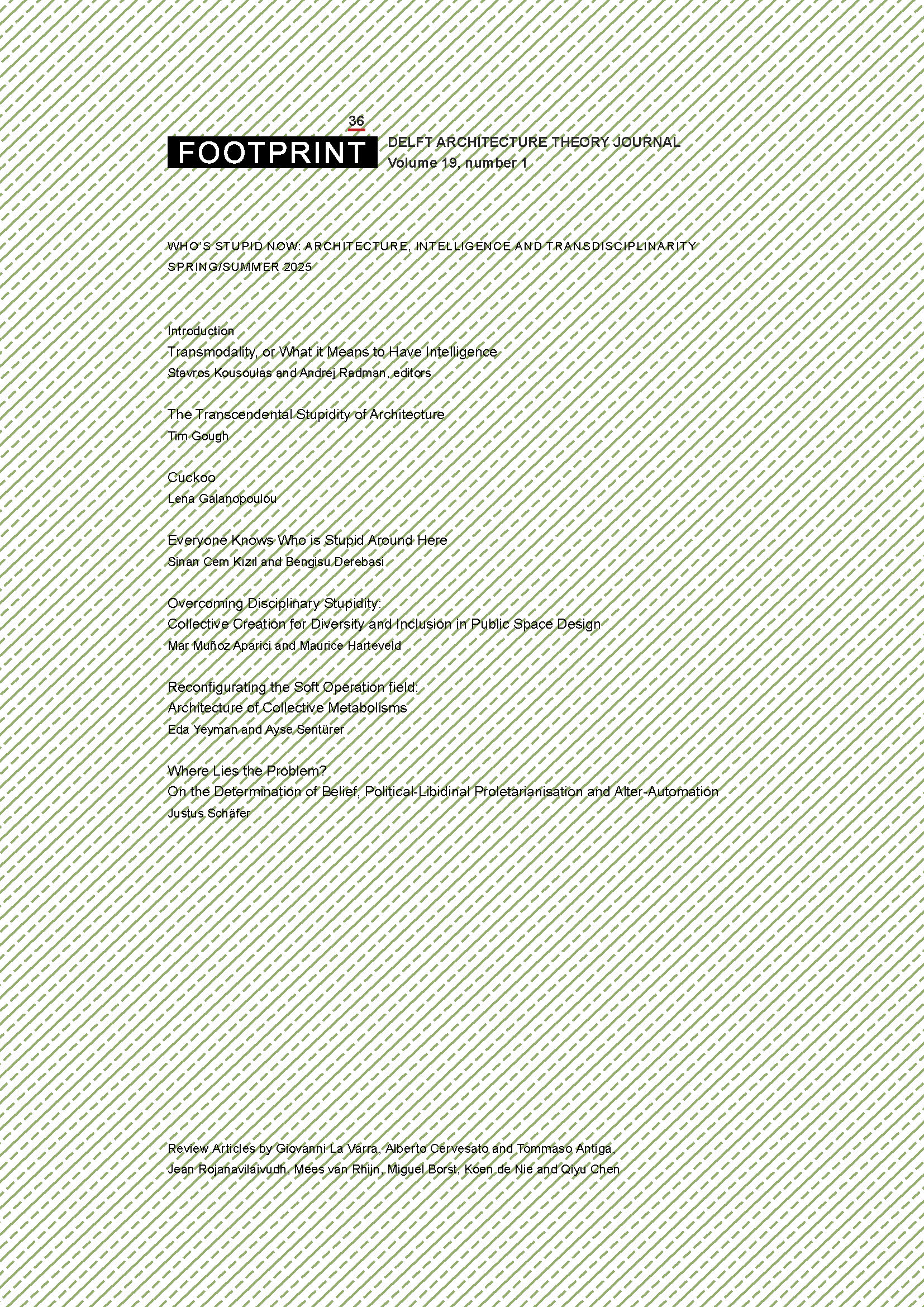A Fantastic Guide to the Cybersiren, and Everything Else You Need to Know about the Love, Death, Origins, Characteristics and Chronicles of the Neapolitan Port
DOI:
https://doi.org/10.59490/footprint.19.1.7866Abstract
The separation of Napoli from its port – driven by industrialisation, privatisation and urban neglect – has disconnected the city from the sea. Drawing on the local mythological tradition, the Cybersiren is introduced as an advocate for change and a way to reconnect city, port and people. It is presented as a disruptive force in response to rigid systems of authority and control that currently dominate the Neapolitan port. This is presented in two ways. First, through a guideline that explains the characteristics of the Cybersiren as a queer entity, one that is body- and techno-fluid, is ambiguously alien on the one hand yet familiar on the other. The guideline also speaks of the way in which the Cybersiren attacks, shatters and eventually, dies. Second, these characteristics are translated into a fictional story that uses imagination to consider how change could be brought about in order to foster technodiversity and reconfigure relationships. Mythopoesis, or the formation of a myth, is used as a tool in order to explore how the grotesque could be used to challenge what has become stuck.
References
Bakhtin, Mikhail. Rabelais and His World. MIT Press, 1971.
Boroditsky, Lena. “How Language Shapes Thought” In Scientific American. Scientific American, 2011. http://lera.ucsd.edu/papers/sci-am-2011.pdf.
Buonoconto, Mario. Napoli Esoterica. Newton & Compton, 1996.
Cassano, Franco, Norma Bouchard, and Valerio Ferme. Southern Thought and Other Essays on the Mediterranean. Fordham University Press, 2012.
De Martino, Paolo. Land in Limbo: Understanding Path ¬Dependencies at the Intersection of the Port and City of Naples. AE+B | Architecture and the Built Environment, 14 May 2021.
De Martino, Paulo. “Naples: A City Away From Water” In Planning Perspectives 39, edited by John R. and Margaret Gold. Routledge, 2023. https://doi.org/10.1080/02665433.2023.2283867.
Deleuze, Gilles and Félix Guattari. A Thousand Plateaus: Capitalism and Schizophrenia. Translated by Brian Massumi. University of Minnesota Press, 1987.
Fisher, Mark. Capitalist Realism: Is there no alternative?. John Hunt Publishing, 2009.
Freud, Sigmund.”The “Uncanny’” In The Standard Edition of the Complete Psychological Works of Sigmund Freud, Vol. XVII, translated and edited by James Strachey and Anna Freud. Hogarth Press, 1955 [1919].
Haraway, Donna. “A Manifesto For Cyborgs: Science, Technology, And Socialist Feminism in The 1980s” In Australian Feminist Studies, no. 2. Routledge, 1987. https://doi.org/10.1080/08164649.1987.9961538.
Hersey, George. “The Poetic Myths of Naples” In Architecture, Poetry, and Number in the Royal Palace at Caserta, edited by George Hersey. MIT Press, 1983. https://doi.org/10.7551/mitpress/1331.001.0001
Hui, Yuk and Jorge Carrión. “A Revolution of Ideas”. CCCB, 2024. https://www.cccb.org/en/multimedia/videos/yuk-hui-jorge-carrion/243992.
Kayser, Wolfgang. The Grotesque in Art and Literature. McGraw-Hill Book Company, 1966.
Massumi Brian. Parables for the Virtual: Movement, Affect, Sensation. Duke University Press, 2002.
Obrist, Michael and Antonietta Putzu. The Last Grand Tour: Contemporary Phenomena and Strategies of Living in Italy. Park Books, 2023.
Ortese, Anna Maria. The Bay is Not Naples. Short Stories by Anna Maria Ortese. Translated by Frances Frenaye. Collins, 1955.
Research Network for Philosophy and Technology. “Tony Fry - Fiction Forced Futures,” 2024. https://www.youtube.com/watch?v=rD3v2T42UX0.
Resta, Giuseppe. “The Belly of Naples and Displaced Meanings, City-as-Body and City-as-Theatre in Commentaries on the Old Town Risanamento: Deconstructing the Stereotype of the Picturesque” In Writingplace, no. 6. TU Delft OPEN Publishing, 2022. https://doi.org/10.7480/writingplace.6.6353.
Serao, Matilde. “On Naples, 1878-1884: Six Translations” In California Italian Studies 3, no. 1. eScholarship Publishing, 2012. https://doi.org/10.5070/c331014954.
Simondon, Gilbert. On The Mode of Existence of Technical Objects, translated by Cecile Malaspina and John Rogove. University of Minnesota Press, 2017.
Žižek, Slavoj. The Pervert’s Guide to Ideology, 2012. https://archive.org/details/the-perverts-guide-to-ideology-2012-hd
Downloads
Published
Issue
Section
License
Copyright (c) 2025 Miguel Borst, Qiyu Chen, Koen de Nie, Mees van Rhijn, Jean Rojanavilaivudh

This work is licensed under a Creative Commons Attribution 4.0 International License.
- Authors retain copyright and grant the journal right of first publication with the work simultaneously licensed under a Creative Commons Attribution License that allows others to share the work with an acknowledgement of the work's authorship and initial publication in this journal.
- Authors are able to enter into separate, additional contractual arrangements for the non-exclusive distribution of the journal's published version of the work (e.g., post it to an institutional repository or publish it in a book), with an acknowledgement of its initial publication in this journal.





